I play the unique 2001 Tremendous Monkey Ball virtually daily, and when you’ll permit me one brag, I’m fairly good at it. Generally I play to jumpstart my mind within the morning, generally to unwind throughout my lunch break, generally to fill a while within the night. Normally, I select the fifty-stage-long Professional issue, and see how far I could make it with out utilizing a proceed. There’s not often an specific aim right here—I’m simply hanging out in among the best video games ever made.
Tremendous Monkey Ball is so good that not returning to it habitually appears like doing it a disservice. The sport feels good, seems good, and is astonishingly straightforward to select up and play: spend 5 seconds with it and also you’ll perceive fairly actually all the pieces about its design. You’re a man in a ball; there’s a aim on the finish of a floating impediment course; a timer is ticking down. Use the management stick to maneuver. That’s it. Each pixel of what’s onscreen, from the extent geometry to the character animations to the HUD, is designed with a chic, utilitarian exactitude, relaying a relentless stream of complicated data to gamers whereas holding their focus squarely on the middle of the body.
That is essential, as a result of Tremendous Monkey Ball calls for undivided, unbending consideration. It’s a molecular online game. The motion—which occupies kind of the whole thing of the sport’s mechanical house—is so exact that an errant two-millimeter nudge of the management stick can immediately change (or destroy) your method to any given impediment. In my twenty years with Tremendous Monkey Ball, no run has felt remotely comparable. Phases I’ve navigated a whole lot of occasions continuously current new, surprising, thrilling challenges. In every other recreation, this might be spectacular. In a recreation with precisely one verb, it’s a marvel.
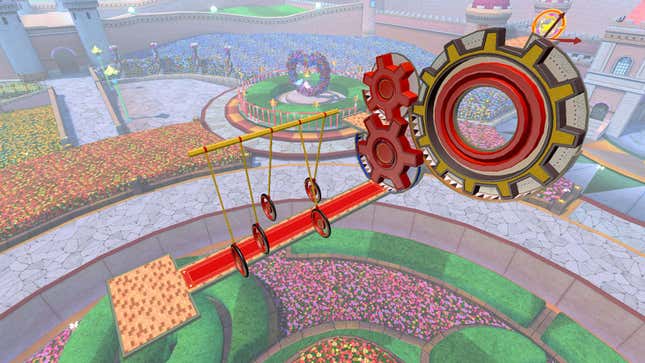
It’s additionally a tough act to observe. Not lengthy after the 2002 launch of Tremendous Monkey Ball 2—an incredible recreation, although damage considerably by its occasional prioritization of mazes and puzzles over brass-tacks platforming—the wheels started falling off. Save for a pair small blips on the radar (right here’s to you, 2006’s Tremendous Monkey Ball: Banana Splitz), the sequence has spent the vast majority of its lifespan in a gradual state of decline, every entry drifting additional away from the rigor and creativity of the GameCube duology. I used to be virtually prepared to go away it for useless after 2021’s Tremendous Monkey Ball: Banana Mania, a remake of the primary two video games that tampered with their physics, flattened their construction, eliminated multiplayer modes, and launched a slew of management and digicam points.
Now, virtually out of nowhere, into our laps falls Banana Rumble, the primary non-remake sequence entry since 2012. I booted up my overview copy with tempered expectations. I’d been burned many occasions earlier than. Lately, even. Think about my reduction when it wound up being the most effective Tremendous Monkey Ball recreation in over twenty years.
The Meat
In virtually each means that issues, Banana Rumble goes again to the drafting board. No extra leaping, no extra minigame bloat, no extra micromanaging the digicam. Movement controls can be found, however they’re off by default, their toggle squirreled away in a labyrinthine choices menu.
The mere presence of a labyrinthine choices menu needs to be encouraging to anybody who was pissed off by Banana Mania’s sparse customizability. Relaxation straightforward, veteran ballers: Banana Rumble permits for changes to, amongst different issues, enter show, computerized digicam pace, handbook digicam pace, stick useless zones for each character and digicam management, stage tilt severity, and stage tilt pace. (I examined these latter two, and so they don’t appear to have any bearing on physics.) For those who’re hankering for a extra conventional setup, do what I did and disable the handbook digicam solely whereas cranking computerized monitoring as much as the max. Congratulations, you’re enjoying Monkey Ball similar to mama used to make.
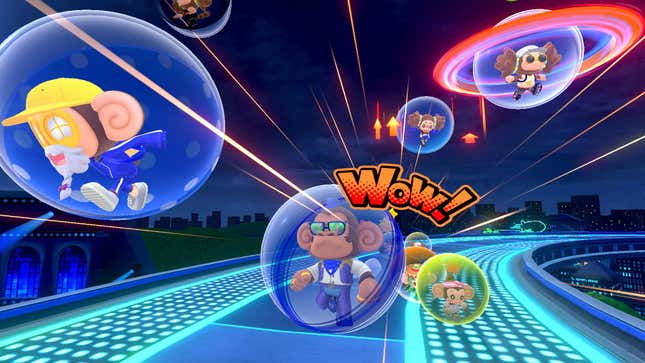
Even out of the field, a superb chunk of this recreation is mama’s Monkey Ball, albeit with some important changes to the components—principally for higher, sometimes for worse. The creamy nougat middle is Journey Mode: 200 miniature platforming gauntlets, none longer than sixty seconds. These are evenly break up into twenty worlds, the primary ten of which comprise the story, the remaining ten of that are for “the actual heads.” (As is sequence custom, the story right here is hopelessly dumb and I spent your entire recreation wishing it could go away. We’re again, child!)
Tremendous Monkey Ball lives and dies by the energy of its degree design. At its easiest, every particular person stage pushes you towards some new, minute understanding of the sport’s physics, brutally ramping up issue in tandem. At its worst, you get one thing like Tremendous Monkey Ball 3D, the place each course is a flat, dinky, Denny’s youngsters’ menu maze that doesn’t train you something about something, not to mention itself. Banana Rumble, fortunately, falls into the previous camp the overwhelming majority of the time. A handful of phases are designed as brainteasers first and uncooked execution checks second, however even then, there’s an virtually complete lack of homogeneity. Ranges really feel distinct and, for the primary time in I can’t keep in mind how lengthy, genuinely tough. Banana Rumble really cares about the way you play it; it needs you to fastidiously take into account each curve, edge, and hole in its geometry.
There’s one key addition to the sport’s motion that basically alters this relationship: the spin sprint, a transparent nod to Sonic the Hedgehog’s iconic maneuver of the identical title. In Sonic, spin dashes let gamers successfully construct momentum from a complete standstill, the pace of their snap ahead dependant on what number of occasions a button is pressed in fast succession. Previous to Banana Rumble’s launch, I assumed its spin sprint would operate identically, and was frightened. A lot of Tremendous Monkey Ball’s stress arises from the varied methods it asks gamers to barter slopes, and the power to shortly reverse course with a burst motion possibility would, if not negate that stress, diminish it significantly.
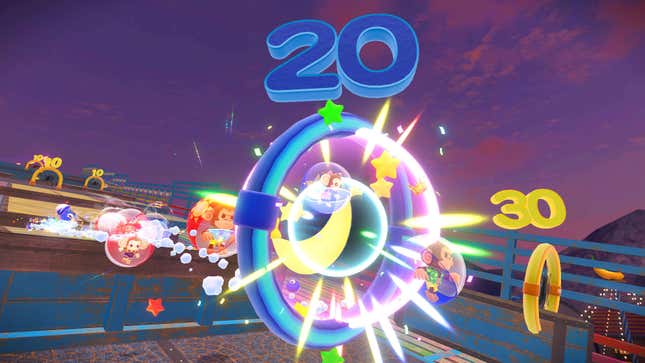
Fortunately, the nice people at Sega have been two steps forward of me. The spin sprint in Banana Rumble is a momentum extender, not a momentum generator. Attempt utilizing it whereas stopped and it received’t ship you wherever. You could be transferring, and when you’ve constructed a little bit of pace, you need to use the spin sprint to maneuver means farther. A good looking little nesting doll of commitments.
I’m nonetheless undecided this sequence actually wants something greater than its elementary management scheme. The purist in me needs to deride the spin sprint, no matter its implementation—why complicate one thing so pristine? However perhaps I’m approaching this the flawed means. Possibly it isn’t a query of what Tremendous Monkey Ball wants, however of what Tremendous Monkey Ball needs. Tremendous Monkey Ball wants a ball, a degree and a timer like we’d like meals, water and shelter. However what it needs is momentum. It needs you to delicately chain a number of exact inputs into seamless, buttery propulsion, and it needs you to spend money on that propulsion. No time to renege; roll (yup) with it and see what occurs. The spin sprint aligns with this ethos completely. If this have been the primary Tremendous Monkey Ball recreation, I’d most likely need it to indicate up in all the long run ones, too.
And it’s not like Banana Rumble doesn’t make good on the spin sprint’s promise. Many ranges are explicitly designed round it, and plenty of extra are subtly designed round it. As soon as I started utilizing the sprint extra liberally, slingshotting simians by means of the air simply to see the place they’d find yourself, the sport revealed its hand. There are shortcuts tucked into each nook and cranny of Banana Rumble if you recognize the place to look. Understanding alternate options to programs has at all times been probably the most rewarding challenges of Tremendous Monkey Ball, and right here we now have a recreation constructed for it from the bottom up. At occasions, these shortcuts can really feel low-cost, however for each degree trivialized by the spin sprint there are ten extra that demand stringent, high-stakes functions of it.
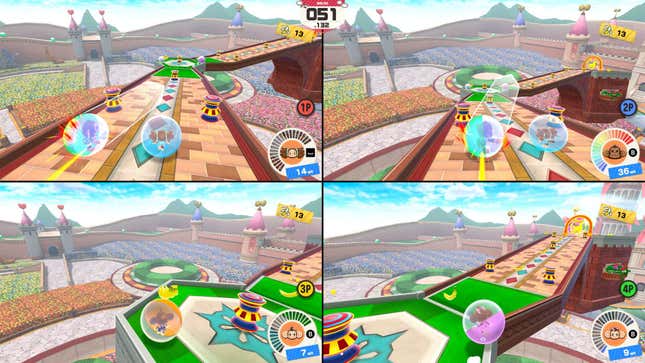
Rounding out Banana Rumble’s core modes are various multiplayer video games, solely a few which resemble previous sequence staples. Gone are the likes of Monkey Golf, Monkey Bowling, Monkey Billiards, and—sigh—Monkey Goal. Monkey Race (rebranded right here as simply “Race”) returns, alongside a couple of others that each one scan as makes an attempt to court docket the Fall Guys platformer-as-battle-royale viewers. None of them are particularly charming, although I suppose they routinely outclass Fall Guys by advantage of not making you are feeling such as you’re swimming laps by means of a tar pit. I respect that these minigames all protect and iterate upon Banana Rumble’s core motion (together with the spin sprint) as a substitute of adopting solely new management schemes (the usual in previous Tremendous Monkey Balls), however all of them come out the opposite finish feeling a bit samey. Race, essentially the most barebones, can be the most effective, for exactly that purpose.
The actual jewel right here is multiplayer Journey Mode, making a triumphant return (with on-line performance in addition) after a decades-long absence. This was at all times one of many higher showcases for the sequence’ versatility: put a number of folks in the identical course side-by-side and their approaches to it’s going to virtually instantly diverge in a thousand tiny methods. Ability makes a distinction, positive, however private expression moreso. With sufficient gamers, it’s a dialog.
The Potatoes
The unique Tremendous Monkey Ball is an arcade recreation. That is true each actually (the sport first launched as a cupboard a number of months earlier than it landed on the GameCube) and structurally. Its development techniques demand information of how its ranges work not solely individually, however collectively: avoiding a recreation over on increased difficulties means devising meticulous methods that maximize each effectivity and banana accumulation (100 bananas grant an additional life, and the sport has, for my cash, one of many biggest 1-up sound results within the medium). As an example, sure ranges may be skipped with warp targets, however doing so could put your banana counter at a deficit—one thing you’ll remorse while you’re teetering on the precipice of a wire-thin path with ten seconds on the clock and nil lives to spare. These competing tensions domesticate a holistic understanding of the sport. Conquering it means conquering all of it.
2024’s Banana Rumble is just not an arcade recreation, as a result of arcade video games don’t actually get made anymore, and as with each Tremendous Monkey Ball that’s not an arcade recreation, it really works time beyond regulation to reshape and justify its design outdoors of an arcade framework. There are not any recreation overs, as a result of there are not any lives. There are not any excessive scores, as a result of phases are performed in isolation as a substitute of as a bunch (except time assault mode, which I really like, however it doesn’t do a lot to make the phases really feel like they’re really working in live performance). However the recreation nonetheless has bananas, and it nonetheless retains observe of your greatest occasions.
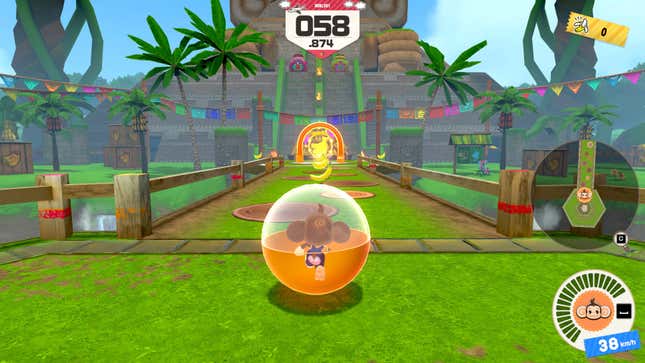
It solves this in two methods, the primary of which is fairly artful. Every degree now has three sub-challenges (which the sport dubs “missions”): a par time, a par banana rely, and a single “golden banana” positioned in a very difficult location. Relying on which one you deal with, your method to the extent will basically change, in ways in which virtually recall the feeling of routing basic Tremendous Monkey Ball difficulties. It’s considerably disappointing that the sport must prescribe these challenges in lieu of letting them emerge organically; however, it additionally signifies that every degree successfully has three smaller ranges folded into it, and I used to be constantly stunned and impressed by how a lot they required me to change my gameplan.
The second resolution is a bit clunkier. As an alternative of a conventional scoring system, Banana Rumble awards factors primarily based on story and mission completion. These factors are primarily used as forex in an in-game cosmetics store, the place you possibly can play dress-up along with your characters, buy new frames for picture mode, and simply usually accomplish fuck all. That is, bluntly, meaningless, and I can’t assist however really feel ambivalent about the truth that many of the recreation’s development terminates right here, in one thing virtually fully dislodged from the abilities and information it asks you to construct elsewhere. Banana Rumble dangles the carrot after which reveals that it’s really cotton sweet; the very last thing a recreation this lean wants is empty energy.
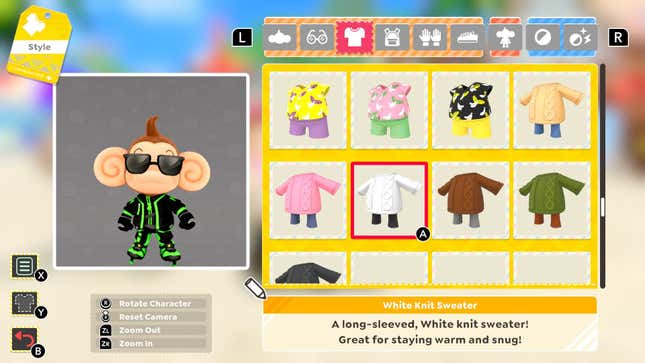
We’ve established what Tremendous Monkey Ball wants; we’ve established what Tremendous Monkey Ball needs; now, lastly, we arrive on the million greenback query. What do I need? On some degree, I do know I simply need the primary Tremendous Monkey Ball. I need elegantly paced arcade modes and intrinsically significant scoring techniques and an unvarnished, elemental management scheme. I don’t need partitioned phases or games-as-a-service-adjacent cosmetics retailers or a dozen totally different characters with distinctive stat spreads.
However these are all bushes; what concerning the forest? What exactly about Tremendous Monkey Ball makes me return to it day after day, yr after yr? The reply is embarrassingly easy: it’s a enjoyable online game. What I actually need once I play Tremendous Monkey Ball is to play a enjoyable goddamn online game. And what more sensible choice? Tremendous Monkey Ball is the stripped down essence of enjoyable video video games. It allows you to do one factor, and that factor is enjoyable, to the best extent that anybody factor in a online game could possibly be.
Banana Rumble is enjoyable. I really like enjoying it. I believed I used to be principally performed enjoying it till, about 300 phrases into this overview, one thing surprising occurred: I acquired The Itch. I’d crushed all the degrees, however I wished to beat them once more. I wished to take a crack on the missions, which I’d largely dismissed as frivolous on my first run. I wished to go for some information in time assault, particularly pre-release, when the sparse competitors would all however assure me a spot within the prime 5. (As of proper now, 6:03 a.m. on June twenty third, 2024, I’ve Large Bomb’s Dan Ryckert crushed by two seconds on the world 1 leaderboards. Dan, when you’re studying this: your transfer.) The sport works, in all of the methods I count on it to. Possibly not in all of the methods I need it to, however so what? Banana Rumble doesn’t must be good. It simply must be good. And for Tremendous Monkey Ball, “good” and “good” are very almost the identical factor.




